Disclosure: Please note that some links are affiliate links, and at no additional cost to you, we earn a commission if you make a purchase.
If you would like to support this website in some way, using these links will help do exactly that.
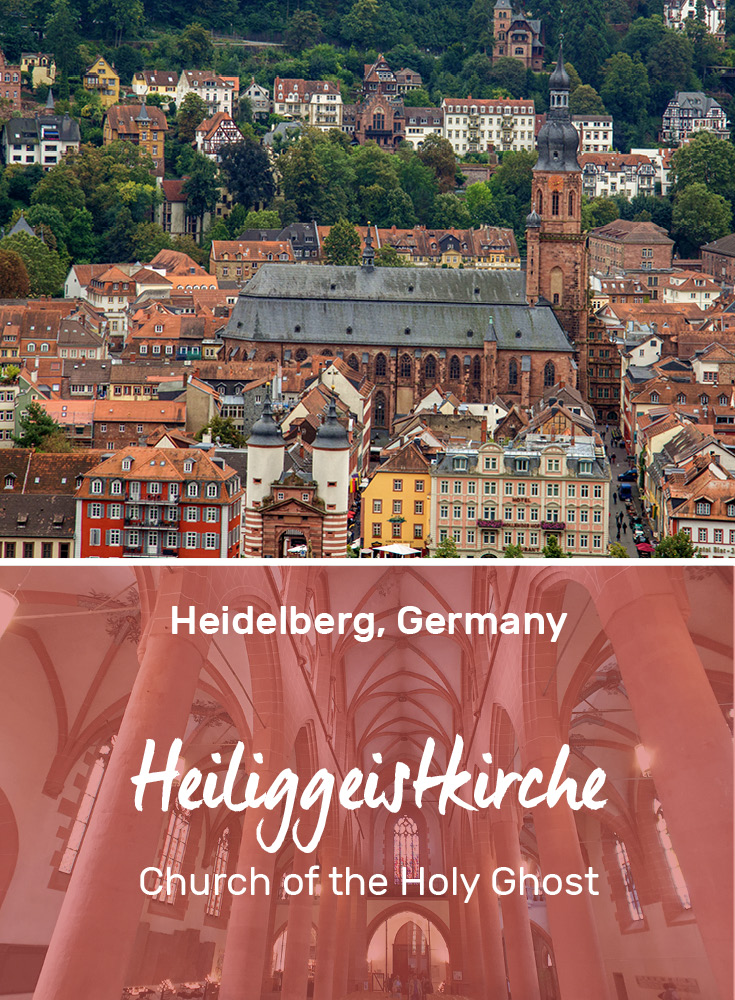
The Church of the Holy Ghost is the largest and most important church in Heidelberg. It is located on the market square in the middle of the town, where its tower dominates the cityscape. The gothic church was built from red sandstone between 1398 and 1515. Originally it was planned as a burial place for the Elector of the Palatinate and as a representative church for the region. Today, only the tomb of the builder of the church choir, Elector Ruprecht III, is still found in the church.
Protestant and/or Catholic Church?
The Church of the Holy Ghost is also known for its changing confessional history. From 1706 to 1936, more than 200 years, the church was divided into two parts by a wall. The nave was Protestant, the choir was Catholic. It was not until 1936 that an agreement was reached with the Catholic church and the removal of the wall was celebrated with a service in the church on June 24, 1936. At last the original spatial impression of the church, as the builders had designed it and wished for, was restored. A memorial plaque at the steps to the choir on the right side recalls this event and give you a pretty good glimpse of where the wall would have been.
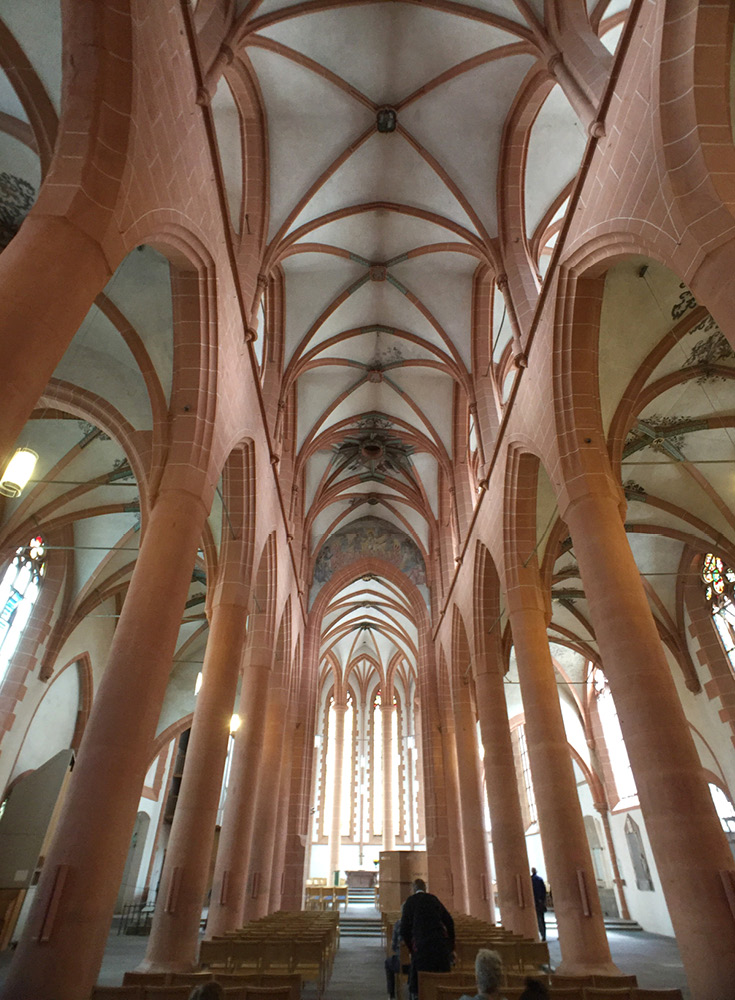
The Church of the Holy Ghost is considered a three-nave hall church and is oriented to the east. The entire church room is divided into two parts, the nave in the front, the choir in the rear. Between the nave and the choir is a triumphal arch. Look around and you will see that the church space looks rather simple, almost a bit empty. This was not always the case. Before the Reformation, the whole church was decorated with magnificent altars, sacred images, and organs. These objects were removed and destroyed during the Reformation period, which started in 1517.
Heidelberg Painter Harry MacLean
Let your view wander up to the arch of the nave and discover the picture on the ceiling called Engelskonzert, Concert of the Angels, from the 15th century. Eight angels with different musical instruments are shown. During a restoration in the 1950s, the Heidelberg painter Harry MacLean added a bassoon to an angel as a reminder of the present.
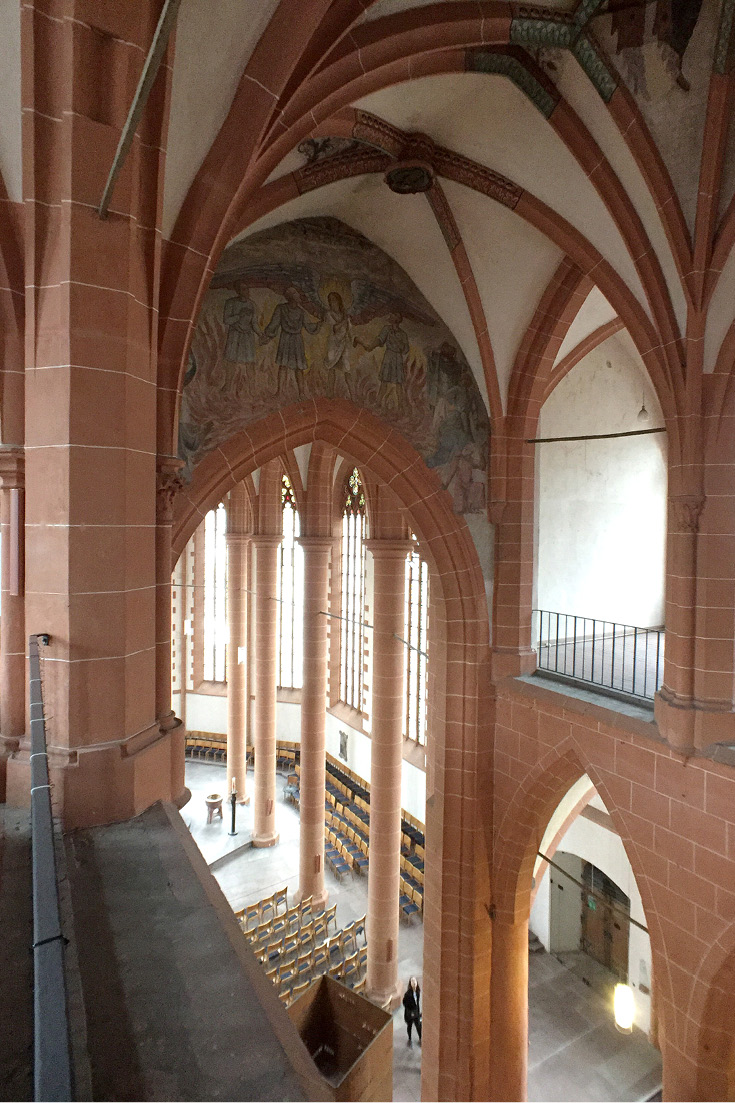
Walking towards the triumphal arch between the nave and the choir, you can spot another painting by Harry McLean from the 1950s. It is called Drei Männer im Feuerofen, Three men in the Fire Stove, and is a story from the Old Testament in the Bible. In the narrative found in Daniel’s book, chapter 3, a king throws the three men into a fire stove, but the fire does not even burn their clothes. The men are uninjured from the oven, forcing the king to believe that there is a God. Let your gaze wander along the high columns, looking towards the organ. Above the organ you will find several spiritual symbols, including a lamb, the hand of God the Father and the dove as a symbol of the Holy Spirit.
Tomb of Elector Ruprecht III
In the middle nave of the chorus, in addition to the closing stones with the Palatine Lion and the Bavarian rhombuses, the slightly larger one with the depiction of an eagle. This is one of the oldest depictions of the German Reichsadler. This final stone crowned in remembrance of the builder of the choir, Elector Ruprecht III. His tomb was originally directly underneath, at the place where the altar stands today. He died in the year of the completion of the new choir in 1410. You can find his tombstone on the northern side nave, directly adjacent to the choir. Engraved into the tombstone are the king with his wife, Elisabeth von Hohenzollern. At the king's feet is a lion, the symbol of the strength and the arms of the Kurpfalz region. At the foot of the queen you can see a dog, the sign of loyalty.
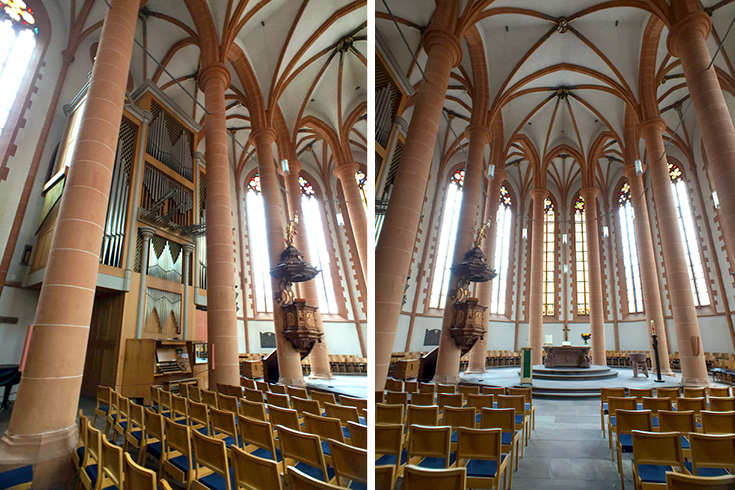
Church Organ
The organ in the church is not as old as you might think. It is called Steinmeyer/Lenter Organ and was the last organ built by the G. F. Steinmeyer & Co. company. The construction of this organ started in 1980 and completed in 1994 by Steinmeyer. It has 63 registers, about 5000 pipes and is the 13th organ to be installed in the Heiliggeistkirche. The intonation (pitch accuracy adjustment) was done by Gerhard Lenter in 1997, which led to a softer sound pattern. Music traditionally plays a special role in the Church of the Holy Ghost. The organ is played every week during the community church services as well as in festive services, and even for classical concerts. Check with the person at the entrance door for upcoming concerts if you want to hear the organ during your visit to Heidelberg.
Tower Tour
End your visit by climbing the 204 steps to the tower. From there you have a wonderful view of the castle, the river and, of course, the city itself. It is well worth the small fee of 2 Euros.
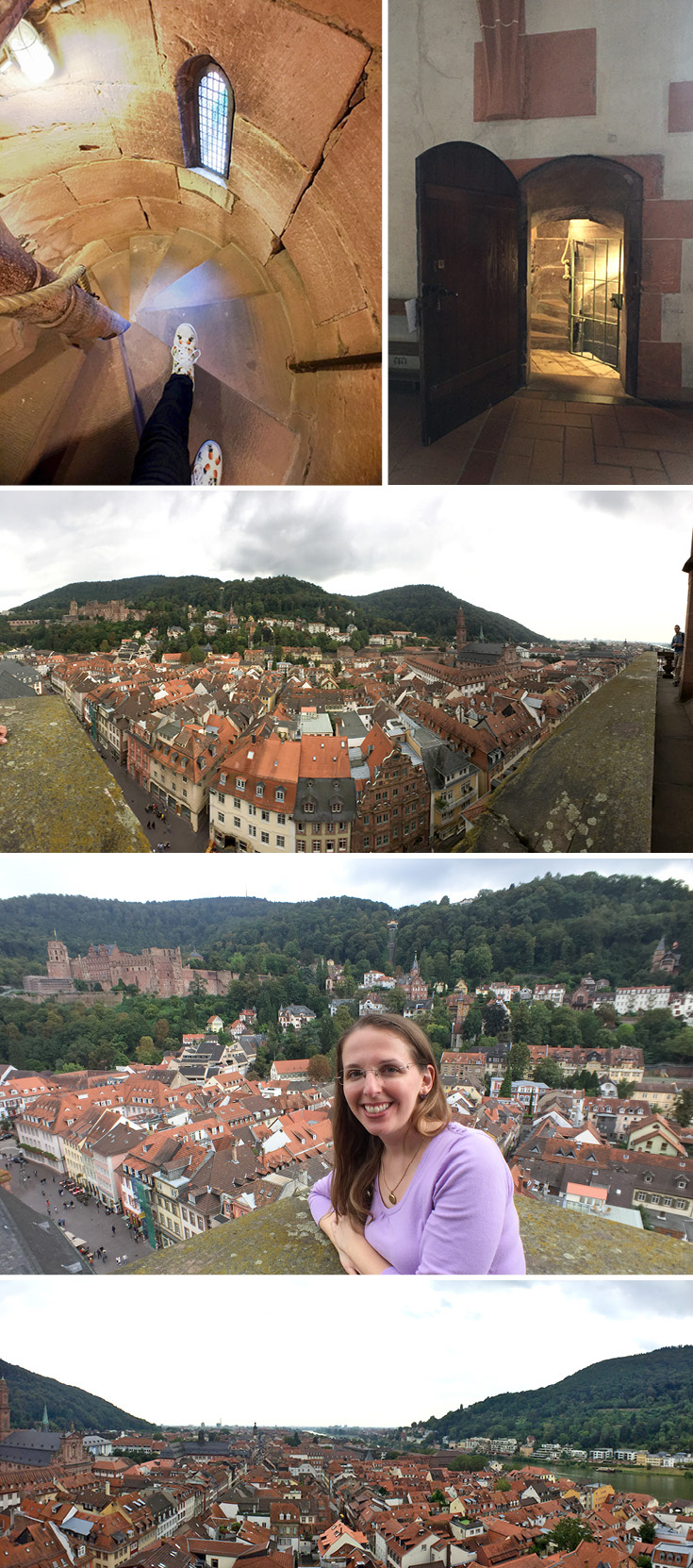
Follow Along
If you enjoyed this article, or these topics sound interesting to you, you'll love our weekly newsletter. You'll receive the newest posts each week and exclusive access to free planning resources like ‘Packing List & Tips for 2 Weeks in Germany’ and ‘Everything You Need to Rent a Car in Germany.
Thank you for reading!

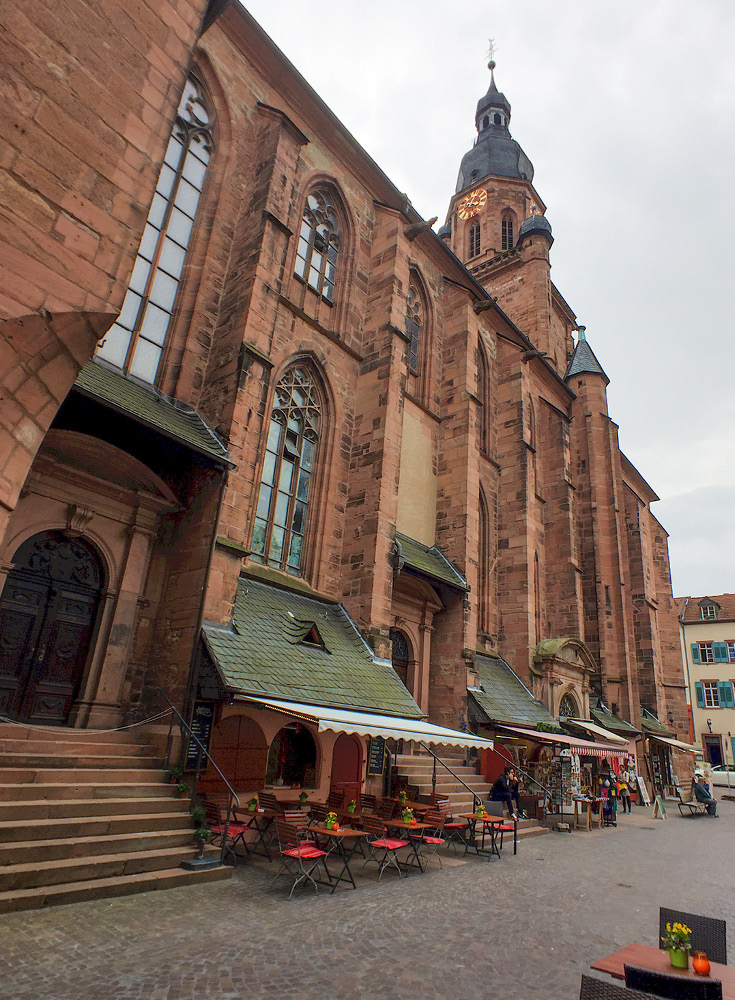
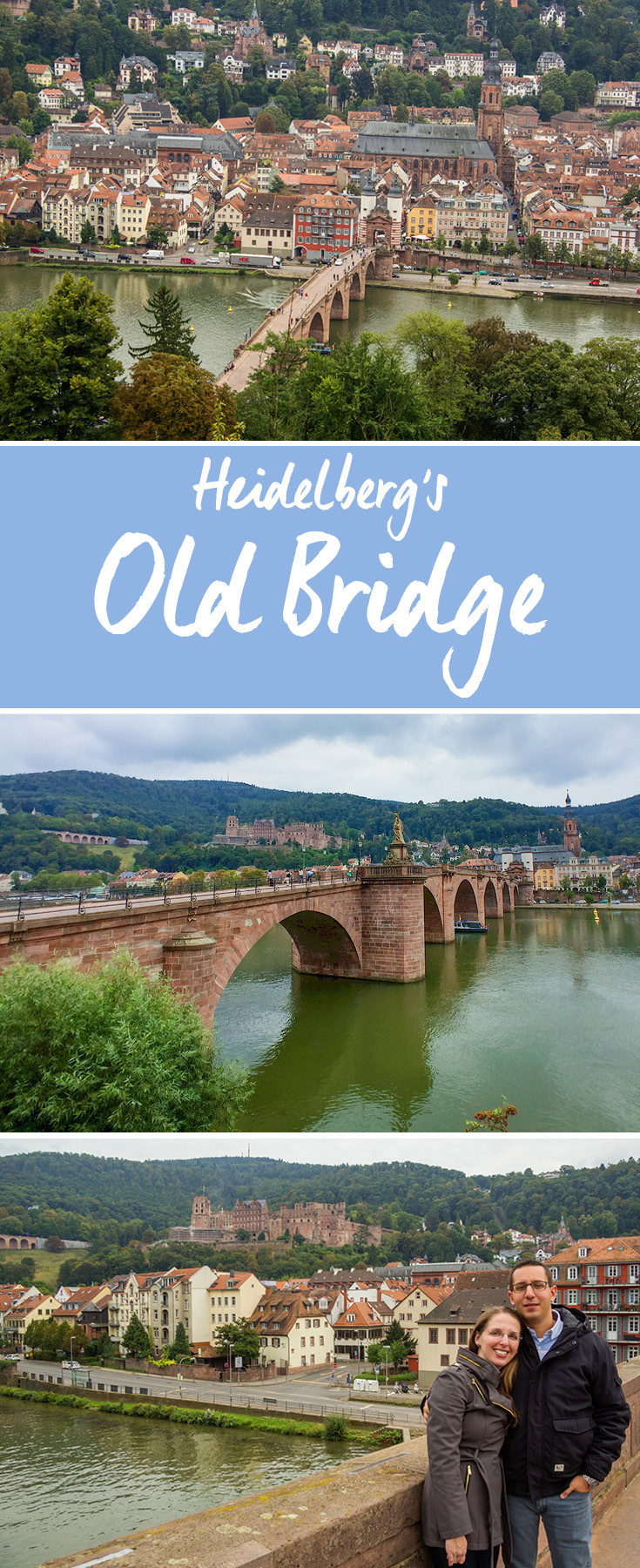
The Old Bridge, officially called Karl-Theodor Bridge, was built from 1786 to 1788 under Prince Karl Theodor, after eight wooden predecessors were destroyed by flooding and wars. It provides a great 360 degree spot for pictures of Heidelberg’s skyline complete with church spires, the castle, and riverfront homes.

Under Attack and Sabotage
If you look in the history books of Heidelberg, the Old Bridge is often mentioned as a place of warfare. The towers served as prisons and as the bridge guards’ domicile in earlier centuries. During the Coalition Wars (1792-1815) the French troops occupied half of the Palatinate up to the river Rhine, and attempted to conquer the Old Bridge, but did not succeed. The bridge you see today was rebuilt after WWII in 1947, when it was partly destroyed for the sake of a strategy. The German military blew up the fifth and sixth bridge pillars to prevent the entry of the American troops into Heidelberg. This approach to “secure” Heidelberg proved useless, the Allied Forces still made it over the bridge. From the 1970’s on, the bridge was modernized and adapted to serve a more modern infrastructure. Today the bridge can be driven on by vehicles between 6am to 10pm, so watch out for cars when you take selfies or watch boats float by. After 10pm, it serves as a pedestrian zone only until the next morning.
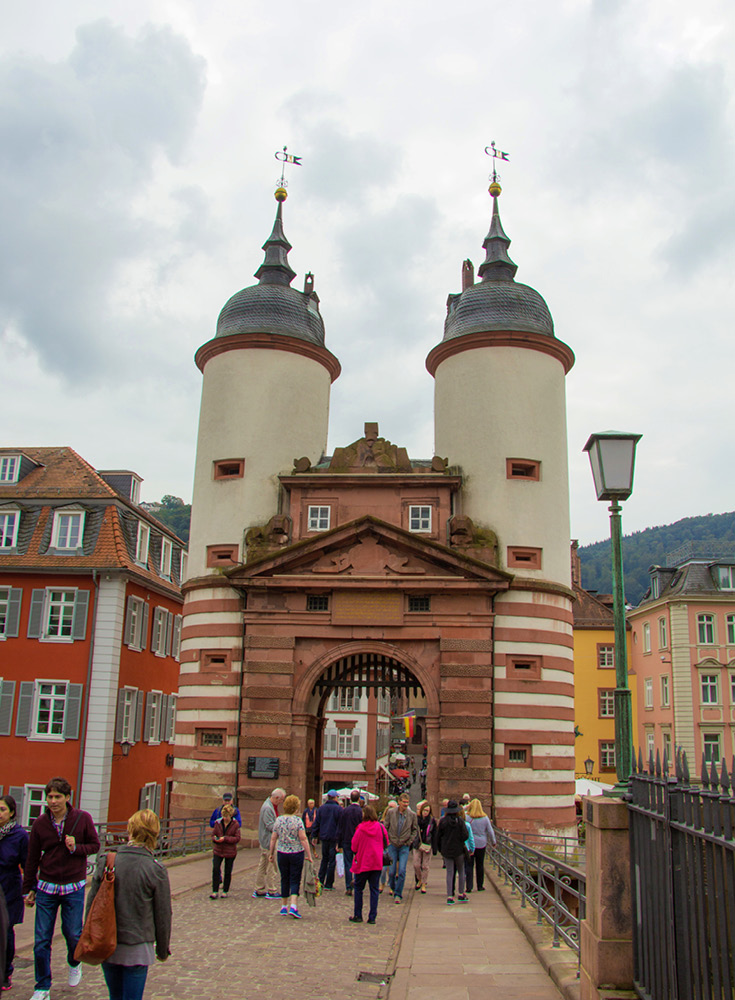
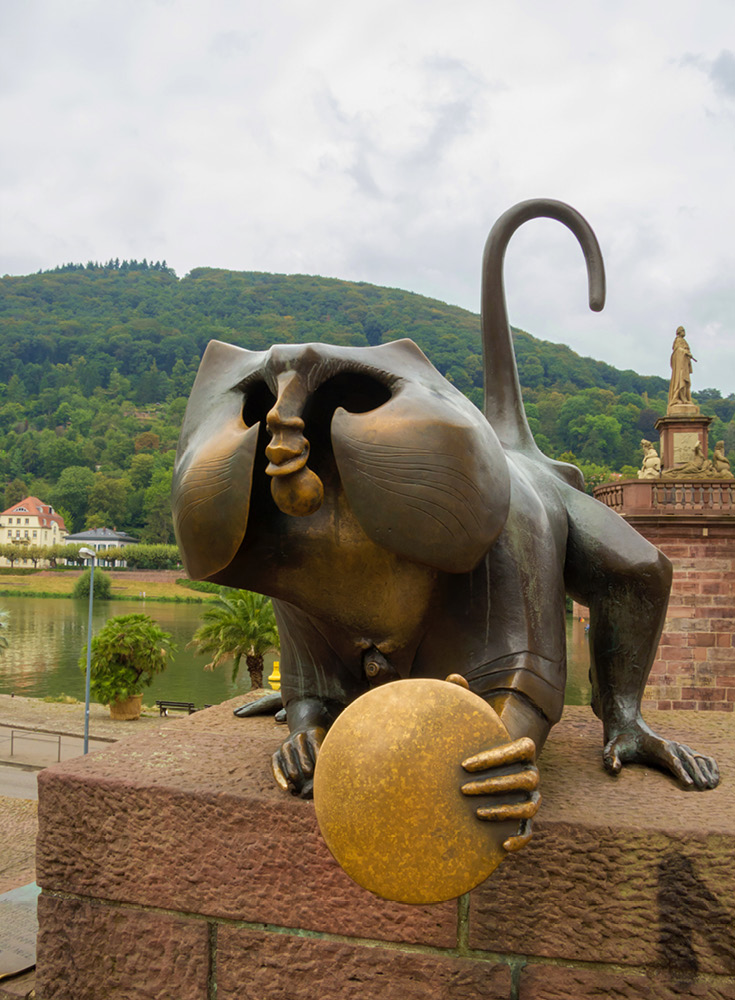
Can’t Miss the Philosophical Monkey
One piece not to miss within all the beautiful surroundings is the bronze monkey. A monkey figure as a city monument has already been mentioned in a poem by German author Martin Zeiller in 1632, which is still written next to the new sculpture (see below for the text). The old monkey figure of the 17th century was destroyed in 1689 and a new monkey was not created until 1979, when artist Prof. Gernot Rumpf re-created it. The new bridge monkey, like the original, holds a mirror in his hand. Everyone that looks or takes a picture of the monkey will see their own face in the mirror. Next to the monkey is a bronze plaque with the following inscription:
WAS THUSTU
MICH HIE ANGAFFEN
HASTU NICHT GESEHEN
DEN ALTEN AFFEN
ZU HEYDELBERG
SICH DICH HIN UNND HER
DA FINDESTU WOL
MEINES GLEICHEN MEHR
This translates to: Look around you or in the mirror, and you will see more specimens of this species. Basically the monkey is telling us not to take ourselves so seriously.
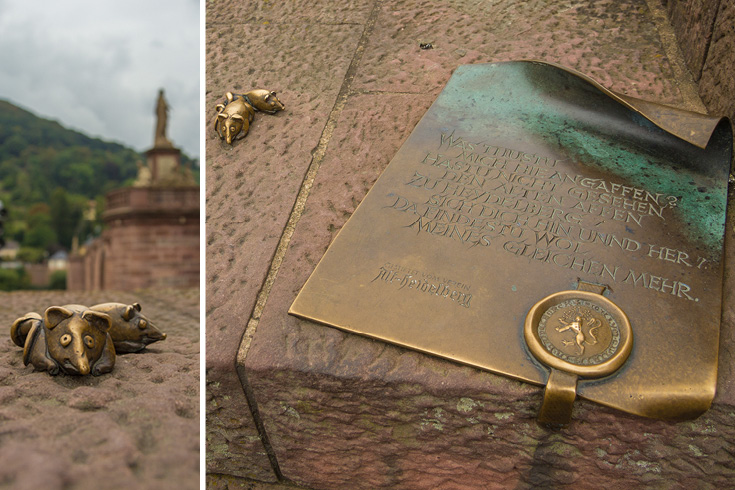
By the way: Beside the plaque you can see 2 mice, which is the creative “signature” of Prof. Gernot Rumpf, who has created the monkey sculpture and many more sculptures and fountains all over Germany. You can see more of his work here.
Follow Along
If you enjoyed this article, or these topics sound interesting to you, you'll love our weekly newsletter. You'll receive the newest posts each week and exclusive access to free planning resources like ‘Packing List & Tips for 2 Weeks in Germany’ and ‘Everything You Need to Rent a Car in Germany’.
Thank you for reading!

Frankfurt am Main is not only known as the European financial metropolis. The city is also one of the most important trade fair locations in Germany. Visitors and exhibitors alike appreciate the size of the exhibition grounds, in addition to Frankfurt's large international airport, the Autobahn and a sophisticated public transport network. Worldwide, only the exhibition grounds in Hanover, Germany are bigger than those in Frankfurt am Main.
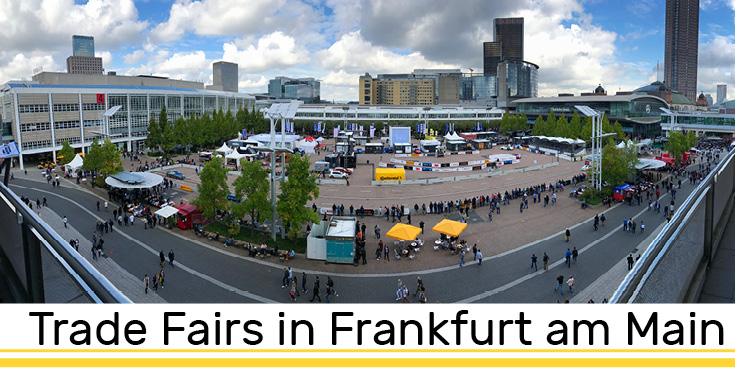
History of Trade Fairs in Frankfurt am Main
The first mention of the Frankfurt Trade Fair is in 1150, when the fairs took place in and around the Roemer marketplace in Frankfurt. During trade fairs in the middle ages, all the guesthouses in Frankfurt were booked, many trade fair guests were accommodated in private houses. While most stands were erected outside the Roemer building, goldsmiths and silversmiths as well as jewelers were given the most exclusive location: they were allowed to build their stands inside the Roemer for better protection of their precious goods. To read more about the Roemer, read our earlier article Deciphering the Roemer in Frankfurt am Main.
Thanks to Frankfurt's geographical location at the crossroads of important long-distance trade routes from and to Lyon, Venice, Antwerp, and Lübeck, the city was the hub of the flow of goods and meeting place for people from all over the world, together with the river Main as a favorable transport route. Everything was traded; from cloths and ceramics to books, cattle and more.
A special status was achieved by the privilege of Emperor Frederick II, who gave the fair visitors the full range of escorts during their return trip starting in the year 1240. Even during their stay in the city their security was ensured. The sequence during the fair weeks was roughly divided into four parts: the escorted arrival week, the actual business week, the week of payments and final dealmaking, and finally the departure week. In 1337, Emperor Ludwig granted the city of Frankfurt the privilege that no other fair could be erected throughout the Lands that could harm the Frankfurt fair in any way.
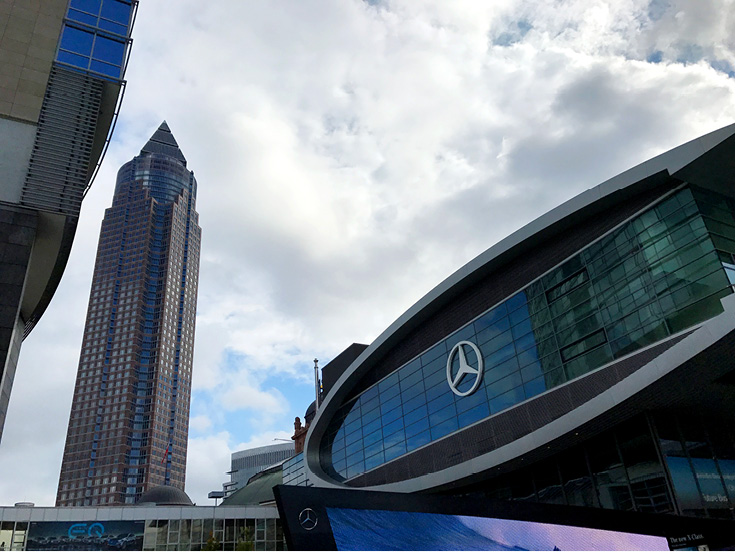
Frankfurt Trade Fair Landmarks
The most prominent building and also one of the highest skyscrapers in Frankfurt is the Messeturm - trade fair tower - with an altitude of 256.5 meters (841.5 feet) and a total of 54 floors. The Messeturm is, however, outside the trade fair grounds and is usually not used for trade fair events. Architecturally, its form stands out, which is why he is also called "pencil" by the people of Frankfurt.
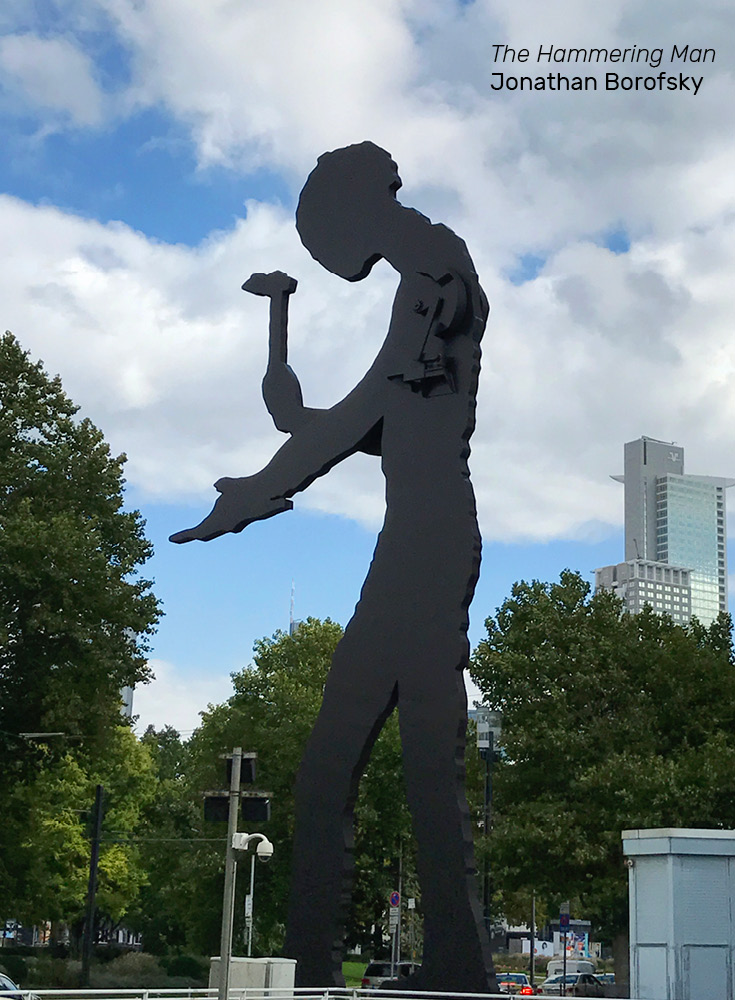
In front of the Messeturm you will find a large, black sculpture by the American artist Jonathan Borofsky called The Hammering Man. The black silhouette shows a worker who moves a hammer against a symbolic workpiece. This sculpture is meant to be a symbol of solidarity for all working people and can be found in various versions all around the world. The statue in Frankfurt am Main weighs 32 tons and was installed in 1991 for the “Art Frankfurt” trade show. This fair for modern art started in 1989 and was canceled due to lack of demand in 2007. The Hammering Man remained.
Today, the fairs in Frankfurt attract more than 1.5 million visitors every year. Every year, the world's largest book fair, Buchmesse takes place here, and the International Automobile Exhibition (IAA) is held every two years in Frankfurt. Most major car brands show all their models in various halls and my dad and I visit every time. This is what the halls look like inside during the International Automobile Exhibition (IAA).
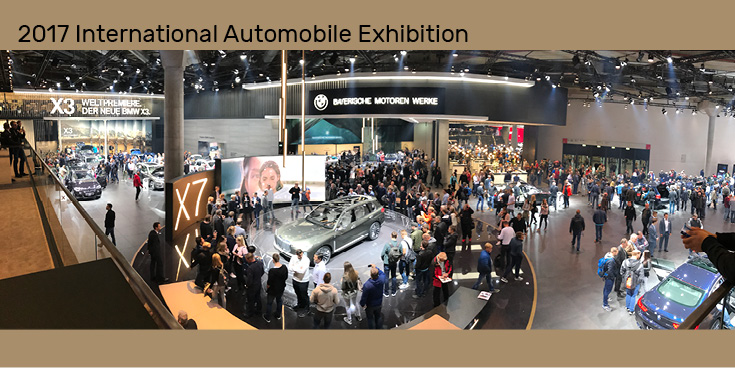
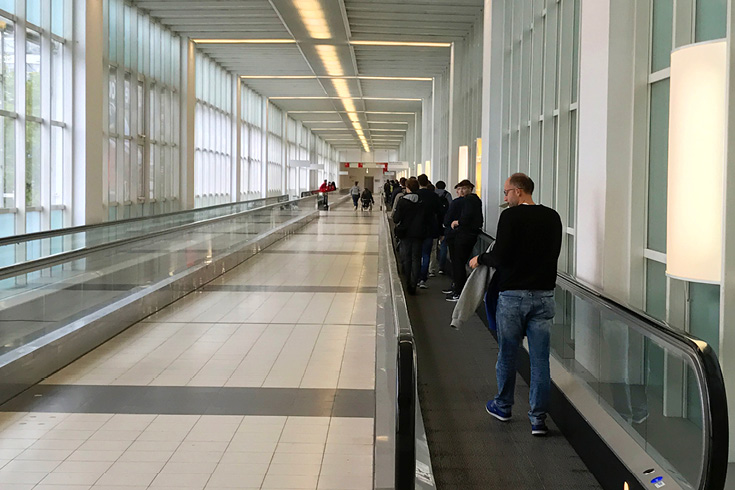
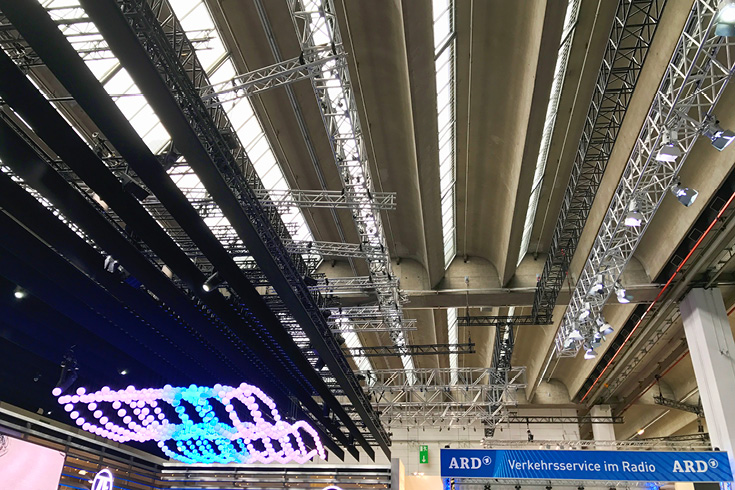
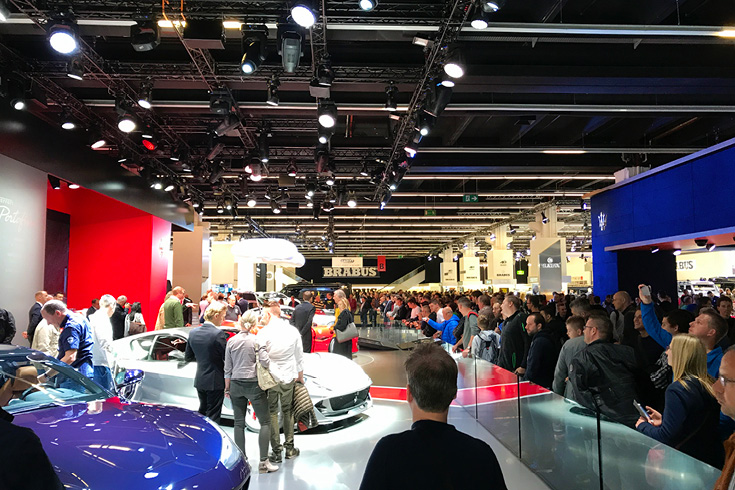
Festhalle in Frankfurt am Main
My favorite hall is the Festhalle, Festival Hall, built in 1907, and also the historic center of the trade fair grounds. It can hold up to 13,500 visitors unseated and is home to concerts, sporting events and Mercedes-Benz during the International Motor Show (IAA) every other year in September. The mixture of tradition and modernity is particularly evident during that time. You see old window panes and historic architecture meet the modern interpretation of beautiful cars by Mercedes-Benz. They also add a lot of light effects, that change every couple of minutes.
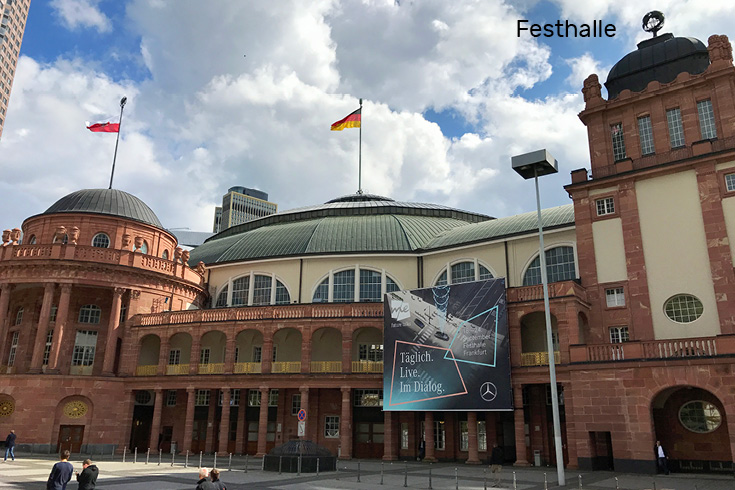
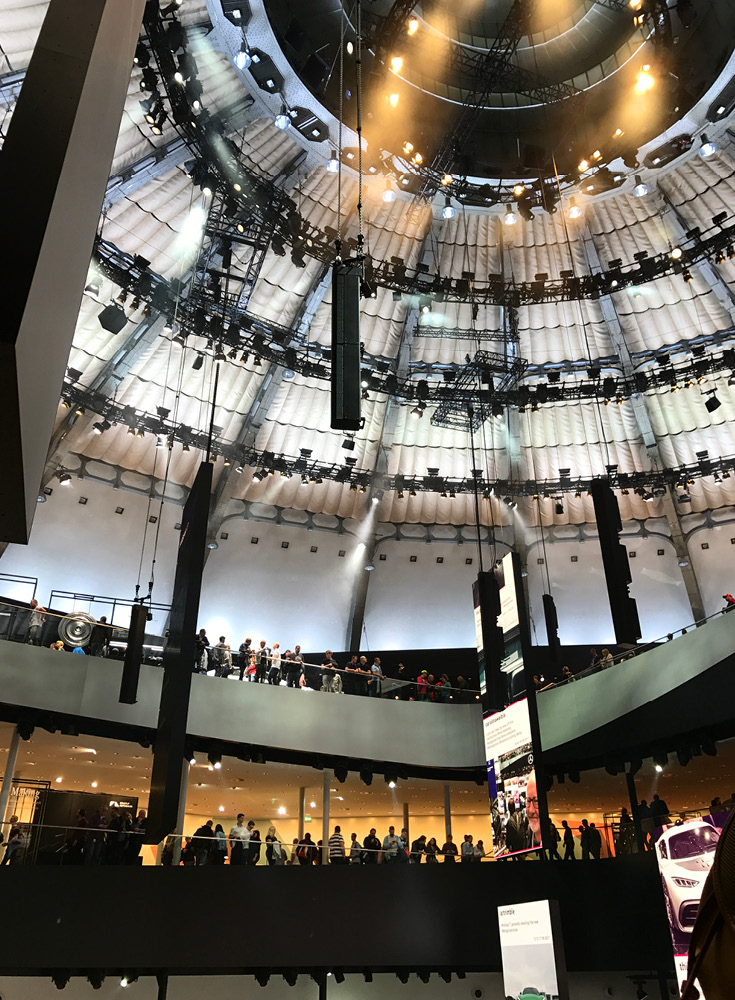
With a total of 11 exhibition halls, the exhibition grounds in Frankfurt offer space for all conceivable topics. Check out this video from Messe Frankfurt to see the whole trade fair grounds. Currently they are working on hall #12 which will be finished in the fall of 2018.
Follow Along
If you enjoyed this article, or these topics sound interesting to you, you'll love our weekly newsletter. You'll receive the newest posts each week and exclusive access to free planning resources like ‘Packing List & Tips for 2 Weeks in Germany’ and ‘Everything You Need to Rent a Car in Germany.
Thank you for reading!

